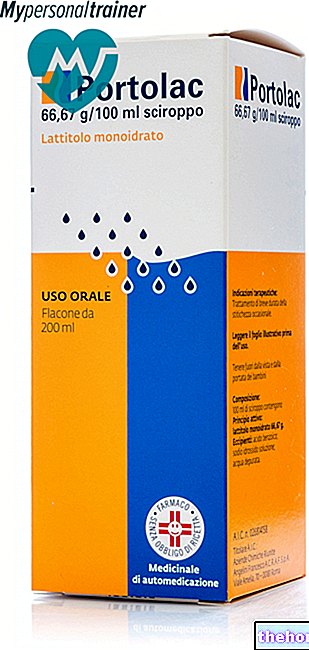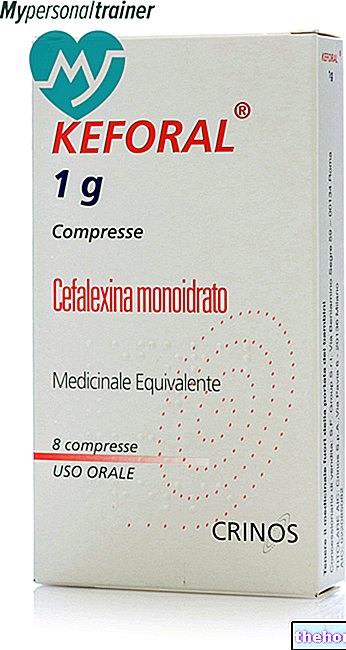Active ingredients: Cefixime
CEFIXORAL 400 mg coated tablets
CEFIXORAL 100 mg / 5 ml granules for oral suspension
CEFIXORAL 400 mg dispersible tablets
Why is Cefixoral used? What is it for?
PHARMACOTHERAPEUTIC CATEGORY
Antibiotic for systemic use, belonging to the class of cephalosporins.
THERAPEUTIC INDICATIONS
CEFIXORAL is indicated in the treatment of infections caused by microorganisms sensitive to cefixime and in particular:
- upper respiratory tract infections (pharyngitis, tonsillitis);
- otolaryngological infections (otitis media, etc.);
- lower respiratory tract infections (pneumonia, bronchitis);
- kidney and urinary tract infections.
Contraindications When Cefixoral should not be used
Hypersensitivity to the active substance or to any of the excipients.
The medicine is also contraindicated in subjects with hypersensitivity to penicillins and cephalosporins (see Precautions for use).
Precautions for use What you need to know before taking Cefixoral
- Antibiotics are indicated only in infections of bacterial origin.
- Antibiotics, and in general all medicines, should be administered with caution to all those patients who have previously experienced allergy phenomena. It is therefore necessary to know if the patient has had any hypersensitivity reactions (allergic or "other type) in the past to cephalosporins, penicillins or other medicines, bearing in mind that it has been established that patients allergic to penicillin may also be allergic to cephalosporins ( partial cross allergenicity), and that, although rare, there have been reports of patients who have experienced anaphylactic-type reactions, especially with injectable medicines. Once therapy with CEFIXORAL has started, the onset of any allergic-type reaction requires the suspension of the treatment.
- In patients with severe renal insufficiency, on hemodialysis or peritoneal dialysis, the dosage of Cefixoral should be appropriately reduced (see Dose, method and time of administration).
- Antibiotics should be used at full dosage for at least 5 days before they are considered ineffective. Antibiotics should be taken at scheduled times.
- Broad spectrum antibiotics should be administered with caution in patients with a history of gastrointestinal disease, particularly colitis.
Interactions What medications or foods may change the effect of Cefixoral
Tell your doctor or pharmacist if you have recently taken any other medicines, even those without a prescription.
Coumarin anticoagulants
Cefixime should be administered with caution in patients treated with coumarin anticoagulants, eg warfarin. Since cefixime may enhance the effects of anticoagulants, an increase in prothrombin time may occur with or without bleeding.
Other forms of interaction
The administration of cephalosporins can interfere with the results of some laboratory tests, causing false positivity of glycosuria with the Benedict, Fehling and "Clinitest" methods (but not with the enzymatic methods). Positive Coombs test (sometimes false) have been reported during treatment with cephalosporins.
Warnings It is important to know that:
The indiscriminate use of antibiotics can cause the development of non-sensitive germs as well as an alteration of the germs that normally live in the intestine (colon flora). In very rare cases a selection of some germs (clostridia) can occur which, increasing by number, can cause a severe form of colitis called pseudomembranous. Mild cases of colitis usually regress spontaneously upon discontinuation of treatment, but if this does not happen, consult your doctor immediately. In such cases, vancomycin should be administered orally, which is the antibiotic of choice in the case of pseudomembranous colitis.
Before starting treatment with CEFIXORAL, a thorough medical history must be collected in order to highlight any previous hypersensitivity reactions towards cephalosporins, penicillins or other drugs.
CEFIXORAL should be used with caution in subjects allergic to penicillins. Partial cross-allergenicity between penicillins and cephalosporins has been ascertained both in vivo (in humans) and in vitro and, although rare, there have been reports of patients who have experienced anaphylactic-type reactions, especially after parenteral administration.
Antibiotics should be administered with caution to all those patients who have previously experienced allergy phenomena, especially towards drugs. The onset of any allergic type reaction requires the suspension of treatment.
In the medium or severe forms, the treatment will be supplemented by the administration of electrolyte solutions and proteins.
The simultaneous use of drugs that reduce bowel motility must be absolutely avoided.
Serious skin adverse reactions such as toxic epidermal necrolysis, Stevens-Johnson syndrome and drug rash with eosinophilia and systemic symptoms (DRESS) have been reported in some patients receiving cefixime. cefixime therapy be discontinued and appropriate therapies and / or precautionary measures initiated.
With the use of CEFIXORAL, slight and reversible changes in parameters related to hepatic, renal and blood crasis (thrombocytopenia, leukopenia and eosinophilia) have occasionally been observed.
In patients with severe renal insufficiency, on hemodialysis or peritoneal dialysis, the dosage of CEFIXORAL should be appropriately reduced (see section: Dose, method and time of administration)
Cases of haemolytic anemia, including severe cases with fatal outcome, have been reported following treatment with cephalosporin class drugs. Recurrent episodes of haemolytic anemia have also been reported following cephalosporin administration in patients who had previously developed haemolytic anemia following first administration with cephalosporins (including cefixime).
Pregnancy and breastfeeding
Ask your doctor or pharmacist for advice before taking any medicine. During pregnancy and breastfeeding, antibiotics, and in general all medicines, should be administered only in cases of real need, under the direct supervision of the doctor. In particular, although no toxic action on the embryo has been demonstrated and although cephalosporins are considered relatively safe even in pregnancy, it is better to avoid the administration of CEFIXORAL, as a precaution, in the first three months of pregnancy. There is no data on the passage of CEFIXORAL into breast milk.
Effects on the ability to drive a vehicle or use machines.
None described.
Important information about some of the ingredients:
Cefixoral 400 mg dispersible tablets contain azo dyes (E110) which may cause allergic reactions.
Dosage and method of use How to use Cefixoral: Posology
The recommended doses are as follows:
Adults: 400 milligrams (mg), equivalent to 1 tablet of CEFIXORAL 400 mg coated tablets or CEFIXORAL 400 mg dispersible tablets, taken orally once daily. The CEFIXORAL 400 mg coated tablet should be swallowed; the dispersible tablet of CEFIXORAL 400 mg can be dissolved in a little water (and then drunk) or swallowed as it is. Taking CEFIXORAL dispersible tablets after dissolving in water is particularly suitable for patients with swallowing difficulties.
Children: 0.4 milliliters (ml) of suspension for each kilo (kg) of body weight, equal to 8 mg / kg, once a day. A calibrated measuring cup and syringe are attached to the package of CEFIXORAL granules to allow the correct dosage of the drug both in older children (measuring cup) and in younger children (dosing syringe). The following scheme facilitates the calculation of the milliliters (ml) to be administered according to body weight:
CEFIXORAL can be administered both close to and away from meals, indifferently. It is advisable to take the drug at the set time in order to maintain constant concentrations in the body.
The safety of cefixime in children weighing less than 10 kg has not been established.
Instructions for opening the bottle
The bottle is equipped with a cap with a "child-proof" safety closure. To open the bottle, press the cap firmly and turn counterclockwise at the same time.
To the granulate contained in the bottle, add water up to the level indicated by the arrow.
After adding the water, shake well until the granulate is completely dispersed.
Wait a few minutes.
If a level of suspension lower than that indicated by the arrow is highlighted, add more water to bring the level back to that indicated by the arrow.
Shake vigorously again.
The suspension thus prepared can be stored at room temperature for up to 14 days, during which it maintains its activity unchanged.
Shake vigorously before use.
There is no need to refrigerate.
Particular dosage regimens
In patients with severe renal insufficiency (creatinine clearance values <20 ml / min), on peritoneal dialysis or on hemodialysis, the recommended dosage is 200 mg once daily. In subjects with creatinine clearance> 20 ml / min., In the elderly and in subjects with hepatic insufficiency, special dosage regimens are generally not required.
DURATION OF THE TREATMENT
All antibiotics should be used at full dosage for at least 5 days, before they are considered ineffective.
Based on experimental clinical data, 7 days of CEFIXORAL therapy may be sufficient to cure most infections. However, in severe cases CEFIXORAL can also be used for 14 consecutive days.
Overdose What to do if you have taken too much Cefixoral
OVERDOSE Up to 2 grams per day (equal to 5 tablets of 400 mg or the whole bottle of granules), CEFIXORAL showed, in healthy volunteers, the same tolerability observed in patients treated with the recommended therapeutic doses. However, in case of accidental ingestion / intake of an excessive dose of CEFIXORAL, notify your doctor immediately or go to the nearest hospital.
IF YOU HAVE ANY DOUBT ABOUT THE USE OF THIS MEDICINAL PRODUCT, CONTACT YOUR DOCTOR OR PHARMACIST
WHAT TO DO IF YOU HAVE FORGOTTEN TO TAKE ONE OR MORE DOSES
If the patient forgets the daily dose at the appointed time (for example in the evening) he should take it as soon as possible (for example the next morning: in this case, two doses will be taken on the same day).
Side Effects What are the side effects of Cefixoral
Like all medicines, this medicine can cause side effects, although not everybody gets them.
With cephalosporins these are essentially limited to gastrointestinal disorders and, occasionally, to hypersensitivity phenomena (allergic or other). The possibility of occurrence of the latter is greater in individuals who have previously experienced hypersensitivity reactions and in those with a history of allergy, hay fever, urticaria and allergic asthma.
The following reactions have been rarely reported during therapy with cefixime:
- Gastrointestinal disorders: glossitis, nausea, vomiting, heartburn, abdominal pain, diarrhea and digestive difficulties. Switching to twice daily administration (200 mg twice a day) can remedy the problem of diarrhea. The onset of severe and prolonged diarrhea has been related to the use of different classes of antibiotics. In this case, the possibility of pseudomembranous colitis should be considered and it is advisable to consult the treating physician immediately.
- Immune system disorders: Serum sickness-like reaction, anaphylaxis, joint pain (arthralgia), drug fever and face edema.
- Blood and lymphatic system disorders: changes in some laboratory parameters: transient decrease in some types of white blood cells (granulocytopenia, in particular neutropenia) and platelets (thrombocytopenia), transient increase in another type of white blood cells (eosinophilia). There have been reports of haemolytic anemia following treatment with cephalosporins.
- Hepatobiliary disorders: jaundice, transient elevation of ALT and AST transaminases, alkaline phosphatase and bilirubin.
- Renal and urinary disorders: transient increase in azotemia and serum creatinine concentrations.
- Respiratory, thoracic and mediastinal disorders: difficulty in breathing.
- Skin and subcutaneous tissue disorders: urticaria, rash, pruritus, erythema multiforme, Steven-Johnson syndrome, toxic epidermal necrolysis, drug skin erythema with eosinophilia and systemic symptoms (DRESS).
- Nervous system disorders: headache, dizziness.
- General disorders and administration site conditions: fever, anorexia, Candida vaginitis.
Compliance with the instructions contained in the package leaflet reduces the risk of undesirable effects.
Reporting of side effects
If you get any side effects, talk to your doctor or pharmacist. This includes any possible side effects not listed in this leaflet. Side effects can also be reported directly via the national reporting system at https://www.aifa.gov.it/content/segnalazioni-reazioni-avverse. By reporting side effects you can help provide more information on safety of this medicine.
Expiry and Retention
Expiry: see the expiry date indicated on the package.
The expiry date indicated refers to the intact product, correctly stored.
Warning: do not use the medicine after the expiry date stated on the package.
CEFIXORAL granules for oral suspension
Store at a temperature not exceeding 30 ° C.
After the addition of water to the pediatric granules, the reconstituted suspension is kept at a temperature not exceeding 25 ° C (not in the refrigerator) and remains stable and active for 14 days.
CEFIXORAL 400 mg tablets
Store at a temperature not exceeding 30 ° C.
CEFIXORAL 400 mg dispersible tablets
Store at a temperature not exceeding 30 ° C.
Medicines should not be disposed of via wastewater or household waste. Ask your pharmacist how to throw away medicines you no longer use. This will help protect the environment. Keep this medicine out of the sight and reach of children
Composition and pharmaceutical form
COMPOSITION
CEFIXORAL 400 mg coated tablets
Each coated tablet contains:
- Active ingredient: cefixime 400 mg.
- Excipients: microcrystalline cellulose, pregelatinised starch, dibasic calcium phosphate dihydrate, magnesium stearate. Coating: hydroxypropyl methylcellulose, sodium lauryl sulfate, titanium dioxide, liquid paraffin.
CEFIXORAL 100 mg / 5 ml granules for oral suspension
Each bottle of 100ml 2% contains:
- Active ingredient: cefixime 2.0 g.
- Excipients: sucrose, xanthan gum, sodium benzoate, strawberry flavor.
CEFIXORAL 400 mg dispersible tablets
Each dispersible tablet contains:
- Active ingredient: cefixime 400 mg.
- Excipients: microcrystalline cellulose, hydroxypropylcellulose, anhydrous colloidal silica, povidone, strawberry flavor FA 15757, strawberry flavor PV4284, magnesium stearate, calcium saccharin, orange-yellow dye (E110).
PHARMACEUTICAL FORM AND CONTENT
Coated tablets: 5 tablets of 400 mg
Granules for oral suspension 100 mg / 5 ml: bottle of 100 ml.
Dispersible tablets: 5 and 7 tablets of 400 mg
Source Package Leaflet: AIFA (Italian Medicines Agency). Content published in January 2016. The information present may not be up-to-date.
To have access to the most up-to-date version, it is advisable to access the AIFA (Italian Medicines Agency) website. Disclaimer and useful information.
01.0 NAME OF THE MEDICINAL PRODUCT
CEFIXORAL
02.0 QUALITATIVE AND QUANTITATIVE COMPOSITION
CEFIXORAL 400 mg coated tablets.
Each coated tablet contains:
Active principle:
cefixime 400 mg.
CEFIXORAL 100 mg / 5 ml granules for oral suspension
Each 100 mL vial of 2% granules for oral suspension contains:
Active principle:
cefixime 2 g.
CEFIXORAL 400 mg dispersible tablets
Each dispersible tablet contains:
Active principle:
cefixime 400 mg.
For the full list of excipients, see section 6.1.
03.0 PHARMACEUTICAL FORM
Coated tablets;
granules for oral suspension;
dispersible tablets.
04.0 CLINICAL INFORMATION
04.1 Therapeutic indications
CEFIXORAL is indicated in the treatment of infections caused by microorganisms sensitive to cefixime and in particular:
- upper respiratory tract infections (pharyngitis, tonsillitis);
- ENT infections (otitis media, etc.);
- lower respiratory tract infections (pneumonia, bronchitis);
- kidney and urinary tract infections.
04.2 Posology and method of administration
In adults, the recommended posology is 400 mg / day given once daily (one tablet a day of CEFIXORAL 400 mg coated tablets or CEFIXORAL 400 mg dispersible tablets).The CEFIXORAL 400 mg coated tablet should be swallowed; the dispersible tablet of CEFIXORAL 400 mg can be dissolved in a little water (and then drunk) or swallowed as it is. The assumption of dispersible CEFIXORAL, after dissolution in water, is particularly suitable for patients with functional or organic swallowing difficulties.
In children, the recommended dose of cefixime suspension at 2% is 8 mg / kg / day in a single administration, that is, according to weight (see diagram below):
Cefixoral can be taken indifferently both close to and between meals.
Based on experimental clinical data, 7 days of CEFIXORAL therapy may be sufficient to cure most infections. However, in severe cases CEFIXORAL can also be used for 14 days.
A calibrated measuring cup and syringe are attached to the package of CEFIXORAL 100 mg / 5 ml granules, which allow a precise dosage of the drug in both older and younger children.
Particular dosage regimens
In patients with creatinine clearance values on outpatient or hemodialysis peritoneal dialysis, the recommended dosage is 200 mg once daily. In general, no special dosing regimens are required in subjects with creatinine clearance> 20 ml / min, in the elderly and in subjects with hepatic insufficiency.
For instructions on opening the bottle and preparing the suspension see section 6.6.
04.3 Contraindications
Hypersensitivity to the active substance or to any of the excipients listed in section 6.1.
The medicinal product is also contraindicated in subjects with hypersensitivity to penicillins and cephalosporins (see section 4.4).
04.4 Special warnings and appropriate precautions for use
Severe skin reactions
Serious skin adverse reactions such as toxic epidermal necrolysis, Stevens-Johnson syndrome and drug rash with eosinophilia and systemic symptoms (DRESS) have been reported in some patients receiving cefixime. cefixime therapy be discontinued and appropriate therapies and / or precautionary measures initiated.
If severe skin adverse reactions occur, treatment with cefixime should be discontinued and appropriate therapy instituted and / or appropriate measures implemented.
Hypersensitivity
Before starting treatment with CEFIXORAL, a thorough medical history must be collected in order to highlight any previous hypersensitivity reactions towards cephalosporins, penicillins or other drugs.
CEFIXORAL should be used with caution in subjects allergic to penicillins. Partial cross-allergenicity between penicillin and cephalosporins has been ascertained both in vivo (in humans) and in vitro and, although rare, there have been reports of patients experiencing anaphylactic-type reactions, especially after parenteral administration.
Antibiotics should be administered with caution to all those patients who have previously experienced allergy phenomena, especially towards drugs. The onset of any allergic type reaction requires the suspension of treatment.
Alterations of the intestinal bacterial flora
Prolonged use of antibiotics can cause the development of non-sensitive germs and in particular an alteration of the normal flora of the colon with possible selection of clostridia responsible for pseudomembranous colitis. Mild cases of pseudomembranous colitis can regress with the interruption of treatment. If the colitis does not regress with the adoption of these measures, vancomycin should be administered orally which is the antibiotic of choice in case of pseudomembranous colitis.
In the medium or severe forms, the treatment will be supplemented by the administration of electrolyte solutions and proteins.
The simultaneous use of drugs that reduce peristalsis must be absolutely avoided.
Broad spectrum antibiotics should be administered with caution in patients with a history of gastrointestinal disease, particularly colitis.
Laboratory tests
With the use of CEFIXORAL, slight and reversible changes in parameters related to hepatic, renal and blood crasis (thrombocytopenia, leukopenia and eosinophilia) have occasionally been observed.
Kidney failure
In patients with severe renal insufficiency, on hemodialysis or peritoneal dialysis, the dosage of Cefixoral should be appropriately reduced (see section 4.2).
Hemolytic anemia
Cases of haemolytic anemia, including severe cases with fatal outcome, have been reported following treatment with cephalosporin class drugs. Recurrent episodes of haemolytic anemia have also been reported following cephalosporin administration in patients who had previously developed haemolytic anemia following first administration with cephalosporins (including cefixime).
Pediatric use
The safety of cefixime in children weighing less than 10 kg has not been established.
Cefixoral 400 mg dispersible tablets contain azo dyes (E110) which may cause allergic reactions.
04.5 Interactions with other medicinal products and other forms of interaction
Coumarin anticoagulants
Cefixime should be administered with caution in patients treated with coumarin anticoagulants, eg warfarin. Since cefixime may enhance the effects of anticoagulants, an increase in prothrombin time may occur with or without bleeding.
Other forms of interaction
The administration of cephalosporins can interfere with the results of some laboratory tests, causing false positivity of glycosuria with the Benedict, Fehling and "Clinitest" methods (but not with the enzymatic methods). Positive Coombs test (sometimes false) have been reported during treatment with cephalosporins.
04.6 Pregnancy and lactation
In pregnant and breastfeeding women, the product should be administered in cases of real need, under direct medical supervision.
In particular, although no embryotoxic action has been demonstrated, the administration of CEFIXORAL should be avoided, as a precaution, in the first three months of pregnancy.
There is no data on the passage of the drug into breast milk.
04.7 Effects on ability to drive and use machines
The medicine does not affect the ability to drive and use machines.
04.8 Undesirable effects
With cephalosporins, undesirable reactions are essentially limited to gastrointestinal disturbances and, occasionally, to hypersensitivity phenomena.
The possibility of occurrence of the latter is greater in individuals who have previously experienced hypersensitivity reactions and in those with a previous history of allergy, hay fever, urticaria and allergic asthma.
The following reactions have been rarely reported during therapy with cefixime:
- Gastrointestinal disorders: glossitis, nausea, vomiting, heartburn, abdominal pain, diarrhea and dyspepsia. Switching to twice daily administration (200 mg twice a day) can remedy the problem of diarrhea. The occurrence of severe and prolonged diarrhea has been related to the use of different classes of antibiotics. In this case, the possibility of pseudomembranous colitis must be considered. In the event that the colonoscopic investigation confirms the diagnosis, the antibiotic in use should be discontinued immediately and oral vancomycin treatment initiated.Peristalsis inhibitor drugs are contraindicated.
- Diseases of the immune system: serum sickness-like reaction, anaphylaxis, arthralgia, drug fever and face edema.
- Disorders of the blood and lymphatic system: changes in some laboratory parameters: transient neutropenia, granulocytopenia, thrombocytopenia and eosinophilia. There have been reports of haemolytic anemia following treatment with cephalosporins.
- Hepatobiliary disorders: jaundice, transient increase in serum transaminases (ALT, AST), alkaline phosphatase and total bilirubin.
- Renal and urinary disorders: transient increase in urea nitrogen and serum creatinine concentrations.
- Respiratory, thoracic and mediastinal disorders: dyspnea.
- Skin and subcutaneous tissue disorders: urticaria, skin rash, pruritus, erythema multiforme, Stevens-Johnson syndrome, toxic epidermal necrolysis, drug skin rash with eosinophilia and systemic symptoms (DRESS).
- Nervous system disorders: headache, dizziness.
- General disorders and administration site conditions: fever, anorexia, Candida vaginitis.
Reporting of suspected adverse reactions
Reporting of suspected adverse reactions occurring after authorization of the medicinal product is important as it allows for continuous monitoring of the benefit / risk balance of the medicinal product. Healthcare professionals are asked to report any suspected adverse reactions via the national reporting system. "address https://www.aifa.gov.it/content/segnalazioni-reazioni-avverse.
04.9 Overdose
Up to 2 grams per day, in healthy volunteers, the drug exhibited the same tolerability profile observed in patients treated with recommended therapeutic dosages.
However, in the event of an overdose, gastric lavage may be indicated.
Cefixime is not eliminated from the circulation in significant quantities by dialysis.
05.0 PHARMACOLOGICAL PROPERTIES
05.1 Pharmacodynamic properties
Pharmacotherapeutic group: antibacterial for systemic use, belonging to the class of cephalosporins.
ATC code: J01DD08.
- Mechanism of action:
CEFIXORAL is a new cephalosporin for oral use characterized by a broad spectrum bactericidal activity and by a high resistance to the hydrolytic activity of beta-lactamases. The bactericidal activity of cefixime is due to the inhibition of the synthesis of the bacterial cell wall. it is active in vitro against a "wide range of clinically significant Gram-positive and Gram-negative pathogens.
Cefixime is particularly active against the following genera: Streptococcus (excluding enterococci), Haemophilus, Branhamella, Neisseria, Escherichia, Klebsiella, Proteus, Enterobacter, Pasteurella, Providencia, Salmonella, Shigella, Citrobacter, Serratia. Instead, they are mostly resistant to cefixime: Pseudomonas sp., Staphilococcus sp., Listeria monocytogenes, Bacteroides fragilis and Clostridium sp.
05.2 Pharmacokinetic properties
After a single oral administration of 200 mg the maximum concentration of cefixime in serum is 3 mcg / ml and this level is achieved within 3 to 4 hours.
After a single oral administration of 400 mg the maximum serum concentration is higher (3.5 to 4 mcg / ml), even if there is no direct proportionality with the dose taken.
After the repeated administration of 400 mg / day orally (one or two administrations per day) for 15 days, the serum levels and bioavailability are not modified, which testifies to the absence of accumulation of the drug in the organism.
After the administration of 8 mg / kg of cefixime in suspension, in pediatric patients, serum concentrations similar to those reached in adults after a dose of 400 mg are obtained.
The absolute bioavailability of cefixime is approximately 50% and is not affected by food. In this case, the time required to reach the peak concentration is delayed by approximately 1 hour.
The apparent volume of distribution is 17 liters.
In animals, the distribution of cefixime in most tissues (excluding the brain) results in higher tissue concentrations than the M.I.C. of susceptible strains (0.20 mcg / ml).
The elimination kinetics of cefixime are characterized by a half-life of between 3 and 4 hours.
The drug is eliminated unchanged by the kidney (16 to 25%). Extra-renal elimination occurs mainly via the biliary route. No serum or urinary metabolites have been detected in humans or animals.
Pharmacokinetic parameters are slightly modified in the elderly population. The slight increase in serum concentrations, bioavailability and the amount of drug excreted (15 to 25%) do not require modifications of the daily dose in this particular population.
In severe renal insufficiency (plasma creatinine clearance, half-life and peak serum concentrations require a dose reduction from 400 to 200 mg / day.
In case of hepatic insufficiency, elimination is slowed (t½ = 6.4 h), but it is not necessary to change the daily dose.
Protein binding is approximately 70%, mainly with albumin and independent of concentration (at therapeutic dose levels).
05.3 Preclinical safety data
After oral administration the LD50 values were higher than 10 g / kg in mice, rats and rabbits. After iv, ip, sc administration, the LD50 values were higher than 3, 7 and 10 g / kg in the mouse and 5, 8, 10 g / kg in the rat, respectively.
Cefixime was found to be devoid of teratogenic effects and did not affect fertility in the animals tested.
06.0 PHARMACEUTICAL INFORMATION
06.1 Excipients
CEFIXORAL 400 mg coated tablets
One coated tablet contains:
Core: microcrystalline cellulose, pregelatinised starch, dibasic calcium phosphate dihydrate, magnesium stearate.
Coating: hydroxypropyl methylcellulose, sodium lauryl sulfate, titanium dioxide, liquid paraffin.
CEFIXORAL 100 mg / 5 ml granules for oral suspension
One bottle of 2% granules for oral suspension of 100 ml contains:
sucrose, xanthan gum, sodium benzoate, strawberry flavor.
CEFIXORAL 400 mg dispersible tablets
One dispersible tablet contains:
microcrystalline cellulose, hydroxypropylcellulose, anhydrous colloidal silica, povidone, strawberry flavor FA 15757, strawberry flavor PV4284, magnesium stearate, calcium saccharin, orange-yellow dye (E110).
06.2 Incompatibility
None.
06.3 Period of validity
CEFIXORAL 400 mg coated tablets
3 years.
CEFIXORAL 100 mg / 5 ml granules for oral suspension
2 years.
CEFIXORAL 400 mg dispersible tablets
2 years.
06.4 Special precautions for storage
Cefixoral 100 mg / 5 ml granules for oral suspension.
Store at a temperature not exceeding 30 ° C.
The suspension after reconstitution must be stored at a temperature not exceeding 25 ° C.
Once reconstituted, the suspension must be used within 14 days. Do not refrigerate.
Cefixoral 400 mg coated tablets;
Store at a temperature not exceeding 30 ° C.
Cefixoral 400 mg dispersible tablets
Store at a temperature not exceeding 30 ° C.
06.5 Nature of the immediate packaging and contents of the package
CEFIXORAL 400 mg coated tablets
5 tablets of 400 mg in aluminum-PVDC-PVC blisters
CEFIXORAL 100 mg / 5 ml granules for oral suspension
100 ml (100 mg / 5 ml) in amber glass bottle + measuring cup + measuring syringe.
CEFIXORAL 400 mg dispersible tablets
5 and 7 dispersible tablets of 400 mg in aluminum-PVDC-PVC blisters
06.6 Instructions for use and handling
Instructions for opening the bottle
The bottle is equipped with a cap with a "child-proof" safety closure. To open the bottle it is necessary to press the cap firmly and turn counterclockwise at the same time.
Instructions for preparing the suspension
Add water to the granules contained in the bottle up to the point indicated by the arrow.
After adding water, shake well until the powder is completely dispersed.
Wait a few minutes; if the suspension level is lower than that indicated by the arrow, add more water to bring the level back to that indicated by the arrow.
Shake vigorously again.
The suspension thus prepared can be stored up to 14 days during which it keeps its activity unchanged.
Shake the bottle containing the suspension well before use.
07.0 MARKETING AUTHORIZATION HOLDER
A. Menarini Industrie Farmaceutiche Riunite s.r.l.
Via Sette Santi 3, Florence.
08.0 MARKETING AUTHORIZATION NUMBER
CEFIXORAL 400 mg coated tablets
5 tablets - A.I.C. n. 027134030
CEFIXORAL 100 mg / 5 ml granules for oral suspension
A.I.C. n. 027134105
CEFIXORAL 400 mg dispersible tablets
5 tablets - AIC n. 027134081
7 tablets - AIC n. 027134079
09.0 DATE OF FIRST AUTHORIZATION OR RENEWAL OF THE AUTHORIZATION
Date of first marketing authorization: CEFIXORAL 400 mg coated tablets
01/04/92.
CEFIXORAL 100 mg / 5 ml granules for oral suspension
1/6/00.
CEFIXORAL 400 mg dispersible tablets
5 and 7 tablets: 10/25/01.
Renewal of the authorization: May 2010
10.0 DATE OF REVISION OF THE TEXT
AIFA Determination of: December 2013




























